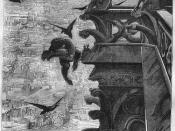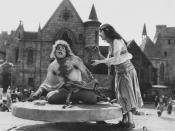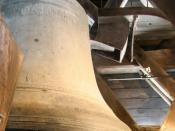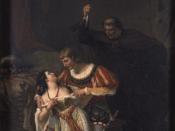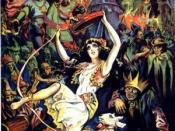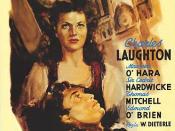The Hunchback of Notre Dame is based on Victor Hugo novel, which is written with the desire to re-create a portrait of medieval Paris and gain support for preserving the Gothic architecture that Victor admired. Generally, Disney's animated features are well known for two things, stunning visuals and musical numbers that accomplish many Academy Awards. The Hunchback of Notre Dame, 34th animated feature, is a carefully constructed film with stunning visuals and inspiring music. Music makes a great contribution to this beautiful film, and is written by Alan Menken and Stephen Schwartz. Moreover, music for The Hunchback of Notre Dame shows an atmosphere full of turbulence and emotion with four basic musical aspects of a film: instrumentation, style, function, and unity.
The very first step in listening to film music is to identify the type of musical instruments and voices that one hears. There are numerous possible instrumentations for a film: symphonic orchestra, sole voice, or single instrument.
The orchestra offers variety of musical colors, and powerful range of dynamics. The Hunchback of Notre Dame surrounds with powerful orchestra and the sound of cathedral's bells, which is the very soul of the film. From the beginning, the sound of the bells introduces listeners to the magnificent cathedral of Notre Dame in Paris, which represents the setting of the story. Later, the orchestra is combined together with the bell ring to deliver the narration. The type of instrument, which is played in this film associates with high class and high level of performance.
The next important step is to recognize the style of the music that is being presented. The Hunchback of Notre Dame is presented with mostly romantic music. This style is flexible, powerful, and does not draw attention to itself. The love theme is played when Quasimodo and the beautiful gypsy dancer Esmeralda first met each other in the festival, when she rescued him from the crowd, and when she came back for him. It emphasizes with rich melodic content, regular pulse, and traditional harmony. Every time the love theme comes up, it represents different kind of love Quasimodo has for Esmeralda. When he first met Esmeralda, his love for her was a tender as love-at-first-sight. We can see the glowing in his eyes arises at the same time with the music scale. Later, as soon as he realizes that Esmeralda is in love with Phoebus, Quasimodo's love for her turns into sadness and bitterness. However, at the end, Quasimodo sacrifices his love to let Esmeralda be with Phoebus. This time the love Quasimodo has for her is truthfulness.
Furthermore, musical function is the most significant elements in film. For most film, the music matches the emotions of given scene or moment. In The Hunchback of Notre Dame, the open narration is a mixture of a long chant with lyric and the sound of the bells of cathedral. It illustrates the sense of adventure and curiosity "" the image of the magnificent cathedral of Notre Dame towers above all else and the sound of its bells are the very heart of the city. Further, an adventure music background describes Quasimodo's yearning to be out among the people in the square below the tower. Additionally, while he was trying to kill Quasimodo, Frollo revealed his evil deeds-lead to Quasimodo's mother's death. This time the music was added with other small ensembles to show how shock Quasimoto was to hear that news. In a nutshell, musical function is a powerful force and plays a significant dramatic support in films.
Finally, the last musical aspect in film, unity, creates variety and gives support to dramatic situation. In this part, the music follows the dramatic structure with the techniques of leitmotifs and thematic transformation. A leitmotif is a melody that represents a person, object, or idea in a story. The Hunchback of Notre Dame has numerous leitmotifs: love theme, Bell of Notre Dame, Topsy Turvy, and Heaven's Light. The love theme represents Quasimoto's love for Esmeralda and is played several times through out the film. Additionally, the Bell of Notre Dame stands for the sense of adventure and curiosity and is the most memorable theme of the film. Further, Topsy Turvy theme represents the cheerfulness, happiness, and excitement of the festival and is presented three times through out the film. Furthermore, the Heaven's Light theme symbolizes religious as being positive and beneficial- anyone who stays inside the cathedral finds sanctuary in it.
In conclusion, music absolutely plays a significant role in film. Even though The Hunchback of Notre Dame was not a tremendous financial success compared to other Disney's animated features, it is a beautiful film with inspiring music. The sound of the bells alone is the spirit of the film, because it presents the glorious cathedral of Notre Dame, the setting of the story, and sense of adventure. Additionally, the romantic style of the music illustrates Quasimodo's love for Esmeralda in different stages: tenderly, sadly, and truly. Furthermore, the music matches with the mood of the emotions of a given scene. When Quasimodo is alone in the tower, the music creates an isolated atmosphere describing him as a lonely, and deformed bell-ringer. Finally, the unity of the music in The Hunchback of Notre Dame supports the drama structure with the use of leitmotifs. There are several themes in the film depicts certain drama situation. The love theme describes different kind of love Quasimodo has for Esmeralda, Bell of Notre Dame theme presents the sense of adventure, Topsy Turvy theme represents the excitement of the festival, and Heaven's Light theme shows the positive of religion.
